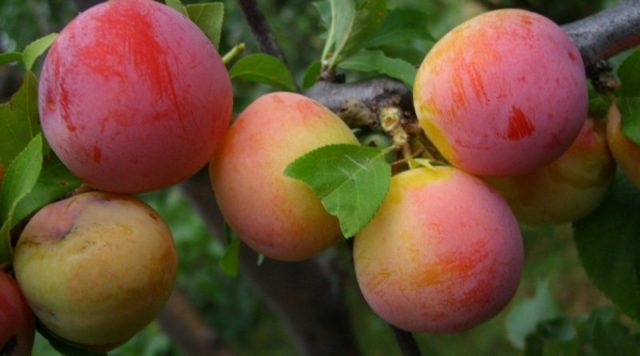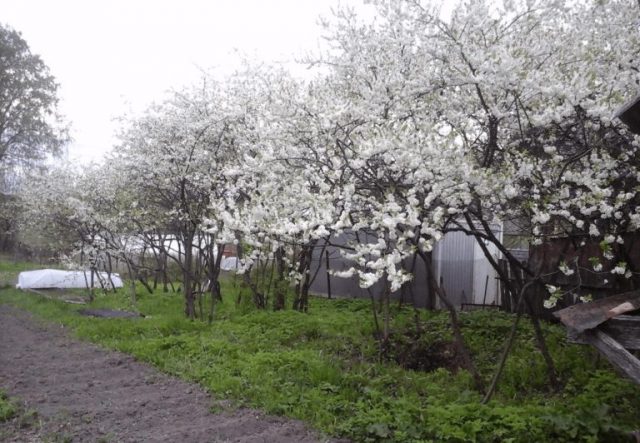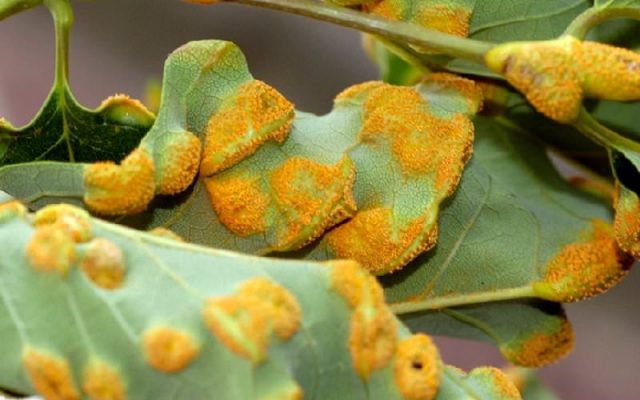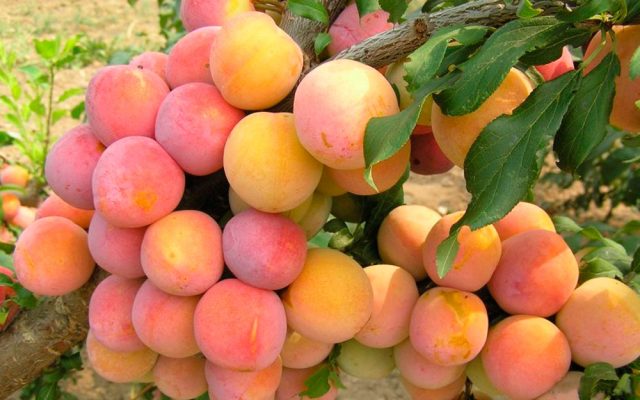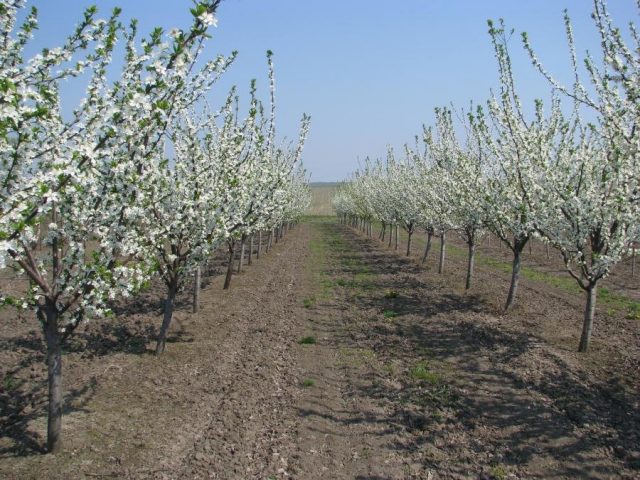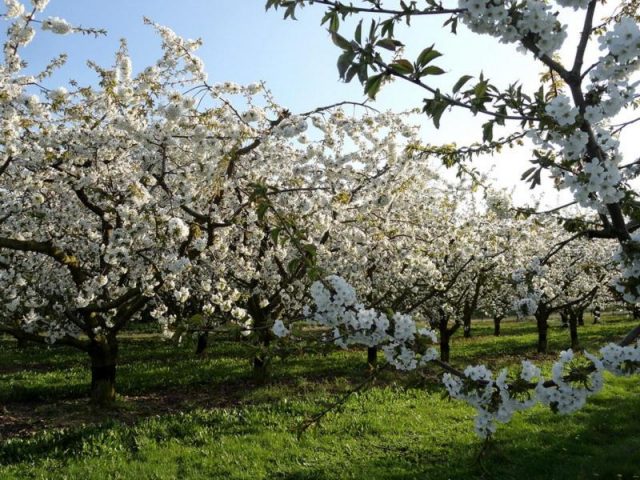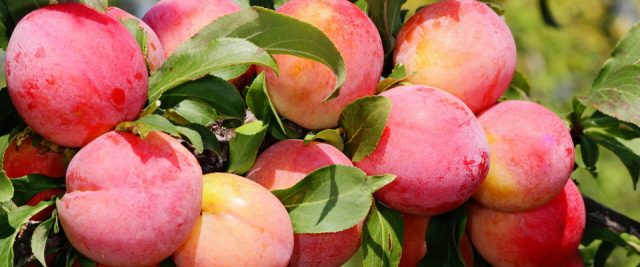Content
Fruit trees are associated with warm climates, but some of them are able to grow in almost all weather and natural conditions. Altai plum is a vivid example of such a tree.
Breeding history of the variety
The Altai Jubilee variety belongs to the category of rather old ones: it was bred in Altai in the mid-70s, and in 1974 a record about it appeared in the State Register. The progenitors of the home Jubilee were the Immune Plum and the Manchurian Prune.
Description of plum variety Altai Jubilee
Altai Jubilee Plum is a medium-tall fruit tree that can grow up to 3 m in height. The branches of the house Yubileynaya are dark, brown-gray, rather thick, covered with slightly curved pale green leaves without edge on the surface.
The shape of the crown is inversely pyramidal, and since there are not so many branches of the tree, the density of the crown remains at an average level. Home plum blooms with large white flowers, 3 from each bud, and an interesting feature is that the flowers appear on the branches earlier than the leaves.
It is very easy to recognize the fruits of the yellow Altai plum. They are almost round in shape, with a pronounced groove, and in color they are yellow, with an orange tint and a characteristic pale scarlet "blush". The wax coating is clearly visible on the skin. One fruit weighs on average about 15 g.
The Altai Jubilee variety is grown throughout the country, in almost all climatic zones. It is recommended for planting in the Urals, in the northern regions of Kazakhstan, in Western and Eastern Siberia. This is precisely its main value: homemade Jubilee perfectly tolerates harsh conditions and bears fruit even in cold regions.
Variety characteristics
You can understand how well the home Jubilee will take root in a particular summer cottage from the detailed characteristics of the variety.
Drought resistance, frost resistance
One of the weak points of the Altai Jubilee is its poor adaptability to arid conditions. Yellow plum does not react well to stagnant water in the soil, but it loves moisture. If it doesn't rain for a long time, 2-3 buckets of water should be poured under the tree trunk every 10-12 days. In addition, additional watering is organized three times a year during the most important periods for yellow plums: before flowering, after its end and during the fruiting season.
If the yellow plum does not tolerate drought, then its frost resistance is very high - and this is one of the strengths of the variety. Despite the fact that in Siberia, winter frosts often exceed -30 degrees and spring frosts are frequent, this does not affect the health of the Altai Jubilee and its ability to bear fruit.
Plum pollinators Altai Jubilee
The yellow plum is not capable of self-pollination - in other words, if you do not plant fruit trees with similar flowering times near your home Yubileynaya, you can not expect high yields. At the same time, there is one caveat: the yellow plum blooms early, respectively, and not all pollinators are suitable for it.
The best options would be:
- Chemalskaya plum - the tree blooms in early May and bears fruit in early July. The variety belongs to the category of frost-resistant, therefore it is well suited for planting in the vicinity of Yubileinaya.
- Plum Katunskaya - early flowering, fruiting in mid-August. Also has good winter hardiness and is suitable for growing in northern regions.
- Plum Memory of Dodgers - dark plum with early May flowering and fruiting in mid-August. Resistance to low temperatures is good - the variety will easily take root next to Altai Jubilee in a harsh climate.
Productivity and fruiting
Home plum begins to bear its first fruits only at 3 or 4 years of age, if an annual tree was used as a seedling. At the same time, the harvest can not be harvested every year, since the variety belongs to the category of irregular.
Plum varieties ripen home Yubileynaya in the middle or at the end of August.
Scope of berries
Unfortunately, the fruits of the home Jubilee are unsuitable for transportation - they can be consumed only immediately after collection. But this does not prevent gardeners from eating fresh yellow plums of this variety, making jams and compotes from them, making jams and adding pulp to baked goods.
Disease and pest resistance
Home plum is not very immune to diseases and insect pests characteristic of plums.
Frequent ailments of the Altai Jubilee:
- chlorosis - the disease appears from an excess of lime in the soil;
- rust - unhealthy yellow spots appear on the green leaves of the Altai Jubilee;
- dwarfism - the tree refuses to grow normally, its leaves decrease, development slows down, the plum can wither completely;
- gum flow - the bark of a frozen or over-fertilized yellow plum begins to exude resin, which becomes a habitat for pathogenic bacteria.
In addition, the yellow homemade Jubilee is often affected by seed eaters and aphids.
Advantages and disadvantages of the variety
If we summarize all the information known about the yellow Altai anniversary plum, then the following advantages can be distinguished:
- increased frost resistance - yellow plum is recommended for breeding even in very harsh climatic regions;
- abundant fruiting;
- great taste of the fruit.
However, the yellow plum also has its drawbacks. These include:
- poor drought tolerance;
- the need to plant pollinators in the immediate vicinity of the yellow plum;
- poor resistance to pests and diseases;
- the inability to transport the fruits of the home Jubilee over long distances.
The Altai anniversary can hardly be called an easy-to-care variety, although it produces very tasty and beautiful fruits.
Planting and caring for plum Altai Jubilee
In order to better understand whether it is worth purchasing a seedling, you need to familiarize yourself with the peculiarities of caring for a plum of this variety.
Recommended timing
It is allowed to plant Altai Jubilee in the ground both in late spring and early autumn - including in Siberia and the Urals.
Choosing the right place
Altai yellow plum loves the sun and fresh air. Planting yellow plums is best on the south or west side. The home Yubileynaya is afraid of stagnation of moisture in the soil, so loam is optimal for growing.
What crops can and cannot be planted nearby
- The best neighbors for yellow plums are apple trees.
- Also, near the home Jubilee, black currants take root, in the shade of a yellow plum, you can plant decorative flowers.
- But pears are best placed at a distance.
Selection and preparation of planting material
The main requirement for a seedling of the Yubileynaya variety is healthy, strong roots. For planting, it is recommended to pick up a one-year or two-year-old seedling, about 1.5 m high.
Landing algorithm
- For the Altai Jubilee, a half-meter deep hole is being dug.
- Fertilizers are placed on its bottom - lime, potassium, organic manure and superphosphate, mixed with the ground.
- The tree is placed in the middle of the hole and the roots are sprinkled with earth, leaving the root collar above the surface.
- The soil around the trunk is compacted, properly watered and mulched.
Plum follow-up care
- For homemade yellow plums, quality watering is extremely important. About 2-3 buckets are poured under the trunk immediately after planting, then before flowering, after it and during ripening. You cannot excessively moisten the earth: the yellow home Yubileinaya does not like this.
- Sanitary pruning for the Yubileynaya variety is carried out at least once a year, more often if necessary.
- Fertilizers applied during planting are enough for the first 3 years of growth. After the homemade Jubilee brings its first harvest, it will need to be fed with organic matter and ash. In the spring, the soil around the trunk can be fertilized with nitrogen, and in the fall - with mixtures containing fluorine.
Before the onset of winter, the Altai Jubilee must be watered again, applied fluoride fertilizers and overlaid the soil around the trunk with spruce branches or agrofibre. Variety home Yubileynaya does not tolerate damping out and with abundant snowfall, and then may suffer during the melting process.
Also for the winter, the trunk can be wrapped with roofing material: Altai Jubilee tolerates frost well, but the cover will protect the yellow plum from rodents.
Diseases and pests, methods of control and prevention
The main enemies of the yellow plum are chlorosis, dwarfism, gum flow.
- The first ailment occurs due to the poor composition of the soil, more precisely, due to the increased lime content. There is only one way out - to transplant the home Jubilee.
- Pruning, Bordeaux liquid and special preparations help from gum removal and dwarfism.
- The scourge of the variety is aphid and seed eater. To combat them, use special formulations, for example, "Lepidocide" and "Actellik".
Conclusion
Altai plum is a frost-resistant, but capricious fruit tree. Careful care of the variety is required, although if the rules are followed, the homemade Jubilee will delight you with juicy fruits.
Testimonials


